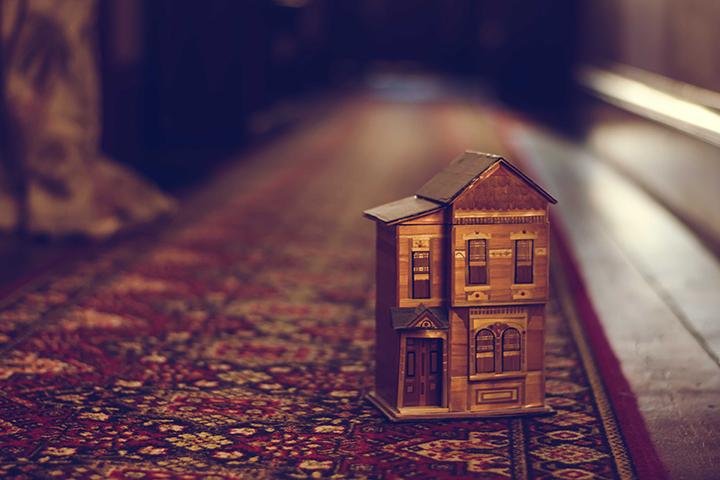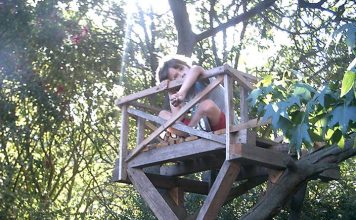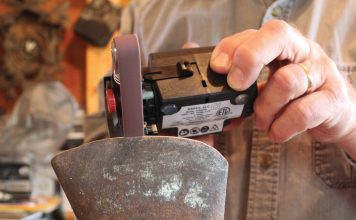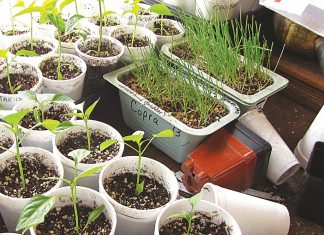| By Claire Wolfe | |
| Issue #92 • March/April, 2005 |
Long ago, I read that to live in the country you must have the soul of a poet, the dedication of a saint, and a good station wagon.
Today I suppose you’d have to update the station wagon to an SUV, but the fact remains: To live successfully anywhere outside the mainstream of life you must have an unconventional spirit coupled with down-to-earth practicalitya combo that can be hard to find and harder still to balance.
I live in the country, but my latest life choices have also involved living in miniature spaceswhich presents an additional set of challenges, both to the soul and to practicality. For the last three years I’ve shared a one-room cabin with a pack of dogs and one outnumbered but boldly unflappable cat. The cabin has an exterior footprint of 409 square feetnine feet above the minimum my county requires for a residence. Its interior space is about 360 square feet, including closets and cabinet space.
I work as well as live here, so I’m in this one room 24 hours a day, except when the critters and I are out dog walking, running errands, picking blackberries, or otherwise adventuring.
On winter days, when I’m tripping over tails, wiping up muddy pawprints for the umpteenth time, and having accusatory canine noses stuck into my computer (“Mom, we’re booooored!”) the cabin sometimes feels as small as a shoebox. On summer afternoons, it’s luxuriously spacious with its glass door thrown open to sunlight and all its denizens sprawled on the deck.
In fact it seems so large that I’m currently contemplating spending part of my year in a structure about one third this size. Think dollhouse (or rather, converted garden shed).
|
I’m hardly alone. Even as the size of the average new American house has more than doubled (from 1,100 square feet during the post-WWII housing boom to more than 2,225 by 1999), more and more people are also exploring small-space living. These include, most visibly, RVers spending months in their cleverly designed rolling homelets, simple-living advocates wanting to use fewer resources, homeless camper-dwellers, folks living on boats, and country newcomers (like many readers of this magazine) who are camping out in garages, trailers, cabins, or sheds while building their dream homes. Finally you’ve got people like me who’d rather have 409 paid-for square feet than 2,225 square feet of mortgaged luxury.
RVers and boat dwellers have built-in advantages. Literally built-in. RVs and boats, with their endless crannies, hidden storage spaces, and double-purpose furnishings (like tables that turn into beds) provide the construction model for the rest of us.
But there’s more to small-space living than just clever design. Living well in tiny spaces has four parts:
- Coping
- Building
- Gadgeting
- Decorating
Let’s take a brief look at all four. Oh, and before we do, I’ll confess that a lot of my knowledge comes from what I-didn’t-anticipate, or I-didn’t-do when I built my cabin. It was a learning experience.
Successful coping
Copingthe actual art of getting along in that tiny spaceis logically the fourth thing to consider, since after all, you can’t do it until you’ve built and furnished. But unless you’re interested in doing what it takes to “live small,” there’s no point in even thinking about the other three steps.
Living small inevitably brings some surprises.
For instance, most people automatically assume that a smaller house requires less housework than a big one. First learning experience: In small spaces, every dirty dish left on the counter, every pile of bills you set on a tabletop upon return from the Post Office, becomesproportionallya big mess. Unlike in a large house, they’re right there in your face. They might be taking up your only work space or eating area. Also, when all your activities are confined to one small space, that space will get dusty and dirty more quickly than when your activities are spread around 2,000 square feet.
So …
- Plan to cultivate neatnik habits. Find a place for everything and put everything in its place as soon as you’re done with it.
- If you can’t immediately put things away, then have a transitional junk drawer or cabinet where you stash stuff until you can file, fold, sort, or dispose of it. (This is in addition to your usual junk drawer where you keep odds and ends on a long-term basis. I know you have one; everybody does.)
- Above all, banish clutter from your kitchen countertops. Eliminate small appliances you don’t need. Stash those you do need inside cabinets. Buy the under-cabinet mounting types of appliances where feasible. Buy or construct a countertop “appliance garage.” An uncluttered kitchen is the biggest step toward small-space sanity.
- Don’t own a lot of stuff. If you can do without it, do without it.
- If you can’t do without it, cheat. Build yourself a small garden shed, rent a storage bin, or purchase one of those $350 Rubbermaid instant-sheds at your local garden supply, and use that for your extra possessions.
- Resolve that you will never again go on mad acquistion binges, host your entire family reunion, or have giant partiesunless you have them outdoors during nice weather.
Designing and building for living small
Before tackling any small-space building or remodeling project, take a look at the interiors of boats and RVs. Make note of their space-saving design featureslike underbed storage, dual-purpose furnishings, fold-up tables, compact water heaters, and especially the way they turn every bit of “useless” space into a cabinet.
Also look at what boat and RV builders do wrong. My friend, Charles Curley, who spent much of his youth ocean sailing, remembers a table whose swing-up leaf kept everybody on one side of the table from being able to reach the kitchen during meals. He recalls another table whose similar leaf had to be folded down every time anyone wanted to get into the refrigerator. Bad design.
Just as small spaces can actually be harder to keep clean than large ones, they can also be harder to design because they require more clever attention to picky detail. Some tips:
-
- Don’t underestimate the amount of storage you need. This is the biggest mistake I made in planning my cabin. I figured one clothes closet, one linen closet, and the kitchen cabinets were enough for my simple life. I now wish I’d built in at least one entire wall of miscellaneous closets, cabinets, and drawers. Cabinets and drawers are a lot more expensive to construct than simple open space. But don’t scrimp on them. You can never have too much storage.
|
- Open shelves are a budget-minded substitute for cabinets and drawers, but having all your stuff out in the open can be ugly. It’s a terrible dust-collector, besides. If you must use open shelving, get some cheap cafe-curtain rods and plain cotton fabric and make yourself curtains you can pull tight over the face of the shelves to keep out dust and keep from having to look at heaps of stuff all the time.
- Use pocket doors that slide into the wall; that way you don’t have to leave lots of space for doors to swing open.
- Consider constructing (or buying) a platform bed with big storage drawers underneath.
- Consider a Roman-style bathtub, again with a platform underneath. Design it cleverly with a hidden, spring-latch operated panel and you can even use this as your top-secret storage space.
- Build with good attic access or an easily accessible storage loft. The typical hatch-in-the-ceiling access discourages us from using that space above our heads. A generous-sized hatch with a ship’s ladder (or specially constructed folding ladder) encourages use by making access less formidable.
- If you live in tornado country where basements are a necessity, or if you live elsewhere and your budget allows a basement, then you’re ahead of the rest of us. But even if a real basement isn’t in your future, you might have what I call the Thoreau option. In his famous cabin at Walden Pond, Henry David Thoreau had a crude dug-out partial basement where he stored fruits and vegetables. In part of the country where I once lived, very few houses had real basements, but many inexpensive worker’s houses had their water heaters and central heating units placed in similar, crudely dug spaces under the floorboards. (The code bureaucrats may freakor may require at least a concrete pad.)
- If you heat or cook with wood, a pass-through bin for firewood will save space and mess. Build the bin on the outside wall of your house, with a door to insert wood from the outdoors and another, next to your woodstove, to pull the wood inside.
- If you’re building your own kitchen cabinets or having them custom-built, extend them all the way to the ceiling. You may have to use a step-ladder to access the top shelves, but you’ll avoid the maddening waste of standard-height (30-inch) cabinets, which end a foot below the standard 8-foot ceiling. If you must have 30-inch cabinets, then don’t enclose the above-cabinet space with the traditional soffit. Leave the above-cabinet space open and use it to display attractive, seldom-used kitchen items.
- Where feasible, replace traditional walls with half-height walls, pass-throughs, or movable screens. The bigger area you can see, the less cramped you’ll feel. (This has a drawback, though. The more you see, the less easy it is to avoid looking at those dishes on the counter or bills on the table.)
- If you’re really into simple, inexpensive design, and you don’t require insulation in all your walls, then consider leaving an open stud wall for small-item storage. You can install extra cross-braces for shelves and use better-than-stud-quality 2x4s or 2x6s for the uprights. Done poorly, this would be a tacky-looking solution to any storage problem. But when going for a rustic or artsy look, it could be done quite cleverly, augmented with attractive stain or paint.
- Design with multiple use in mind. A built-in fold-down workbench can double as a kitchen table. A kitchen countertop with a knee hole under it becomes a desk.
- Build in bins for dry dog food. Or for bulk human foods like wheat or split peas.
- Build niches to hold your TV and electronic gear. Electronics not only take up a lot of space when sitting out on countertops or tabletops; they take up a lot of visual space. They’re always in your face, wherever you turn. And they’re not pretty. Tuck them into a cabinet-wall and they’ll be easier to live with.
- Whatever else you do, be sure to let in lots of light using glass doors, big windows, skylights, or (depending on your climate) big doors that can stand wide open in summertime. No matter how tiny your interior space, the entire outdoors can still be part of your design.
Helpful gadgets for saving space
Having just touted a relatively “stuffless” existence, it’s a little ironicoh, but so much funto delve into space-saving gadgets. It’s also ironic that so many small gadgets are more expensive than their larger work-alikes. So to keep the budget down, we’ll look at only a few.
-
- Check out under-counter refrigerators, 20-inch-wide ranges, counter-top dishwashers, and small European washer-dryer all-in-ones. (See them at www.compactappliance.com)
- If the exotic washer-dryer combos are beyond your budget (or you worry about getting parts for them), then of course a stacking washer-dryer pair is your friend. I looked at apartment-sized versions but ultimately realized the full-sized models didn’t take up much more space and were a much better buy.
- Replace your desktop computer with a laptop. The traditional problem of the laptop keyboard being too small and cramped for comfortable use is being solved by the new widescreen laptop models. And you can usually attach an external keyboard. They even have folding keyboards if you really want to save space.
- Another computer solution: Charles Curley, Tech Geek Supreme, suggests buying a rack-mounted computer rather than your standard consumer off-the-shelf desktop model. Rack-mounted computers are more expensive, but they’re usually higher quality. And the thing that makes them perfect for small spaces is that they can bolt to the underside of a table, inside a cabinet (if well-ventilated), or in storage space under a platform bed. Then the only space-consuming item you need to worry about is your monitor. And with flat-panel LCD monitors now becoming affordable (under $300), no problem.
|
- Consider getting rid of your range altogether if you don’t cook much. You can replace it with a microwave and a two-burner hotplate. Or cook on your wood stove. Or cook outdoors on a handy, folding stainless-steel Pyromid (which you’ll have to purchase from eBay.com, since these wonderful little devices aren’t currently being manufactured any more.)
- Get a TV with a built-in DVD player. Or get a TV card and use your computer as your TV/DVD player. Or consider your TV among the excess stuff you can get rid of.
Decorating to make small look bigger
Finally, when you’re ready to move your furniture in:
- Use light colors; they make rooms look bigger. Go for white or brushed-metal appliances, white or light wood cabinets, painted (instead of wood) walls.
- Avoid wildly patterned upholstery, bedspreads, or carpets. Muted is good.
- Put nice, big mirrors on your walls, or even a whole wall of mirrored squares.
- Have glass, Plexiglass, or Lucite tabletops.
- Have a tabletop or workbench that folds up against the wall. Use small tables with big leaves.
- Use futons, sofa-beds, or other furniture that can go quickly from compact to full-size as you need it.
To people who’ve never done it, small-space living often sounds cramped and uncomfortable. Certainly it can become that way in a structure that’s poorly designed or if you get sloppy in your living habits.
But be clever and conscientious and you can have a very nice little life while saving a bundle, not only on construction, but on heating, air conditioning, maintenance, and furnishing. Oh yes, and on top of everything else, you’ll be giving the taxers a whole lot less to tax than your neighbors who’re building those 2,225 square-foot palaces.

















